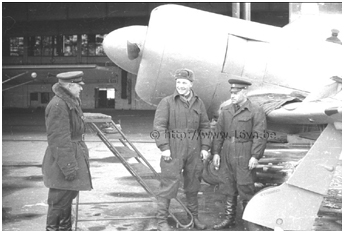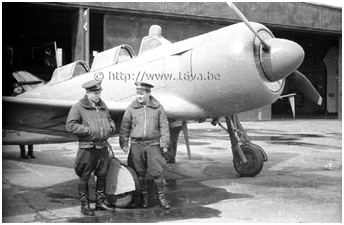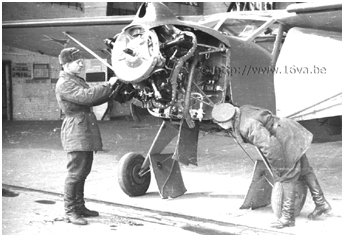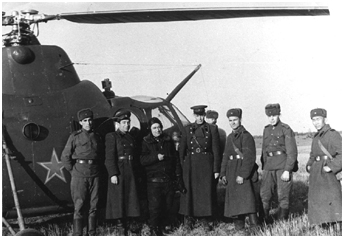
 From the study of the Berezin missions, it is clear that the 931.OKRAP had target-towing and cooperation with the AAA in its assignments. However, we cannot know whether that role was filled
by a squadron, a flight, or a section of the regiment. The numbers of aircraft reported in CIA reports are generally small. But in October 1949, when the 931.OKRAP was based at Köthen, no less than 11
Bostons were observed (> Link). Matyunin, on the other hand, was probably not in the same squadron as Berezin.
The aircraft types in which he flew (Il-2[KR] and Yak-11) were clearly more suited to reconnaissance and spotting. Furthermore, the tow planes did not share the same aerodrome.
One (the 48.OGRAP) or several other non-dedicated units also appeared to fly target-towing
missions. There is no doubt that other regiments towed targets for their own training.
A classic example is that of a fighter towing a windsock so that his fellow pilots can practice air-to-air cannon firing.
CIA often reports observations of target-towing activities within different units. Here are a few examples:
From the study of the Berezin missions, it is clear that the 931.OKRAP had target-towing and cooperation with the AAA in its assignments. However, we cannot know whether that role was filled
by a squadron, a flight, or a section of the regiment. The numbers of aircraft reported in CIA reports are generally small. But in October 1949, when the 931.OKRAP was based at Köthen, no less than 11
Bostons were observed (> Link). Matyunin, on the other hand, was probably not in the same squadron as Berezin.
The aircraft types in which he flew (Il-2[KR] and Yak-11) were clearly more suited to reconnaissance and spotting. Furthermore, the tow planes did not share the same aerodrome.
One (the 48.OGRAP) or several other non-dedicated units also appeared to fly target-towing
missions. There is no doubt that other regiments towed targets for their own training.
A classic example is that of a fighter towing a windsock so that his fellow pilots can practice air-to-air cannon firing.
CIA often reports observations of target-towing activities within different units. Here are a few examples:
- November 1950 at Schönwalde: single-engine aircraft firing on a target towed by a Po-2
(maybe Il-10s of the local 710.GvShAP)
> Link.
- December 1951 at Altes Lager: Il-10 towing a target (maybe aircraft of the local 635. or 725.GvShAP) > Link.
- October 1953 at Zerbst: MiG-15 towing a target attacked by other MiG-15s without firing
(aircraft of the local 35.IAP) > Link.
- February 1954 at Altes Lager: MiG-15 firing at a target towed by an UTI MiG-15 (116.GvIAP or 883.IAP aircraft, both units
based at Altes Lager)
> Link.
- 1954 global: night firing > Link (5th page)
Il-28 firing on a target towed by an Il-28 (bomber units?)
> Link (10th page)
- March 1955 at Parchim: MiG-15 firing at a target towed by an UTI MiG-15 (aircraft of the local 20.GvIAP - mention of the
Il-28s from the local towing section)
> Link.
 Berezin's flight log is unequivocal: most, if not all, towing missions were for AAA training. Specialized units such as the 931.OKRAP or the 48.OGRAP
probably were reserved for this type of mission, while the fighter or ground-attack units could do so without specialized aircraft and aircrews.
Although rare, there are, however, testimonies reporting fighter planes firing on targets towed by Il-28s > Link (10th page).
It seems that a new organization was gradually implemented from the mid-fifties on in order to reserve the towing missions for just the separate target-towing squadrons.
A target-towing section was reportedly created within the 277.BAP in 1954. The latter would have been the forerunner of the 74.OBAE based at Parchim the same year.
In 1956, the 65.OBAE was established at Oranienburg. It would appear, therefore, that establishment of these two specialized squadrons gradually sounded the death knell for target-towing among
other units that practiced it. This may be true as far as cooperation with the AAA is concerned, because, if the Il-28 of the OBAE-type units have indeed been used to drop targets for the missiles of the fighter planes,
there is little evidence to indicate use to allow the latter to practice air-to-air firing with their guns. This aspect of things remains an enigma at present.
It can be said that the 24.VA was not at the forefront in that matter, since there is a trace of a dedicated unit as early as 1952 at Berdyansk
(> Link).
But nothing is simple. For the record, it is worth noting that separate target-towing and spotting aviation squadrons (Otdel'naya BUksirovochnaya KORrektirovochnaya AviaEskadril'ya - OBUKORAE)
once existed in the Soviet Navy!
Berezin's flight log is unequivocal: most, if not all, towing missions were for AAA training. Specialized units such as the 931.OKRAP or the 48.OGRAP
probably were reserved for this type of mission, while the fighter or ground-attack units could do so without specialized aircraft and aircrews.
Although rare, there are, however, testimonies reporting fighter planes firing on targets towed by Il-28s > Link (10th page).
It seems that a new organization was gradually implemented from the mid-fifties on in order to reserve the towing missions for just the separate target-towing squadrons.
A target-towing section was reportedly created within the 277.BAP in 1954. The latter would have been the forerunner of the 74.OBAE based at Parchim the same year.
In 1956, the 65.OBAE was established at Oranienburg. It would appear, therefore, that establishment of these two specialized squadrons gradually sounded the death knell for target-towing among
other units that practiced it. This may be true as far as cooperation with the AAA is concerned, because, if the Il-28 of the OBAE-type units have indeed been used to drop targets for the missiles of the fighter planes,
there is little evidence to indicate use to allow the latter to practice air-to-air firing with their guns. This aspect of things remains an enigma at present.
It can be said that the 24.VA was not at the forefront in that matter, since there is a trace of a dedicated unit as early as 1952 at Berdyansk
(> Link).
But nothing is simple. For the record, it is worth noting that separate target-towing and spotting aviation squadrons (Otdel'naya BUksirovochnaya KORrektirovochnaya AviaEskadril'ya - OBUKORAE)
once existed in the Soviet Navy!
 As we have seen before, Matyunin flew the Yak-11 in 1954. On the other hand, there is a report (> Link) indicating presence of Yak-11s within the 931.OKRAP
at Zerbst. It is likely that the main task of the "Moose" was reconnaissance and artillery spotting.
Three Yak-12 "Creek" were also present at Zerbst. Their section was nicknamed "royal aviation" and clearly, they had replaced the Po-2 as liaison aircraft. Moreover, an Mi-1 squadron, normally of the KR
version, was established in 1955 when the 931.OKRAP was at Zerbst. Its commander from 1955 to 1958 or 1959 was Hero of the Soviet Union A. F. Babenko (see group picture on first page).
He was so honored following the first helicopter flights in the Arctic (> Link). Two Mi-1 of the unit were lost in a mid-air
collision after 1956. In March 1958, Babenko joined Dessau with a few helicopters (probably those equipped with dual control) in order to help the East German pilots during entry into service of the "Hare" in the NVA.
One will note that a 1962 BND report mentions Mi-4 spotter helicopters [TARK versions?] with the "artillery correction regiment" at Stendal - so this occured when the 931.OKRAP was based there.
As we have seen before, Matyunin flew the Yak-11 in 1954. On the other hand, there is a report (> Link) indicating presence of Yak-11s within the 931.OKRAP
at Zerbst. It is likely that the main task of the "Moose" was reconnaissance and artillery spotting.
Three Yak-12 "Creek" were also present at Zerbst. Their section was nicknamed "royal aviation" and clearly, they had replaced the Po-2 as liaison aircraft. Moreover, an Mi-1 squadron, normally of the KR
version, was established in 1955 when the 931.OKRAP was at Zerbst. Its commander from 1955 to 1958 or 1959 was Hero of the Soviet Union A. F. Babenko (see group picture on first page).
He was so honored following the first helicopter flights in the Arctic (> Link). Two Mi-1 of the unit were lost in a mid-air
collision after 1956. In March 1958, Babenko joined Dessau with a few helicopters (probably those equipped with dual control) in order to help the East German pilots during entry into service of the "Hare" in the NVA.
One will note that a 1962 BND report mentions Mi-4 spotter helicopters [TARK versions?] with the "artillery correction regiment" at Stendal - so this occured when the 931.OKRAP was based there.
Berezin ceased flying target-towing missions in 1956.
According to a report given in a link above, the Il-28 target-towing aircraft - and the Yak-11s - were withdrawn from service and replaced by Il-28Rs. Also, the 931.OKRAP would have had in its ranks
MiG-15bis aircraft, logically of the R version. According to the book entitled "The GSFG Celestial Guard" (1), the two "Fagot" that collided in flight,
resulting in the death of their pilots on April 5, 1954 were 931.OKRAP aircraft. Therefore, the unit was composed of three very different squadrons when stationed at Zerbst: one equipped with MiG-15bis [R],
one with Il-28R, and one with Mi-1KR, i.e. one reconnaissance squadron, one spotting and reconnaissance squadron and one artillery correction and spotting helicopter squadron. In May 1958, the regiment
moved to Stendal. It was there that the unit abandoned its spotting and reconnaissance missions to become a full-fledged reconnaissance unit (ORAP). Its composition also became more homogeneous with two squadrons of Il-28Rs.
The rest of the story is told in the fifth part of the chapter "Reconnaissance and Electronic Warfare" > Link.
With special thanks to Igor Berezin for his unstinting help
notes & links
(1)
Nebesny Straj GSVG by E.P. Tolmatchev.
> The 931.OKRAP as seen by the CIA in 1952 <
 |
Flight Logs < Part 1 | < Part 2 | < Part 3 | < Part 4 | < Part 5 |
 |
Plan du site - Sitemap |  |
